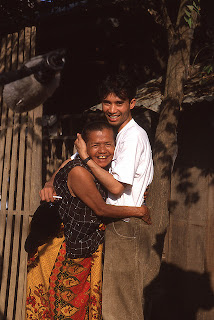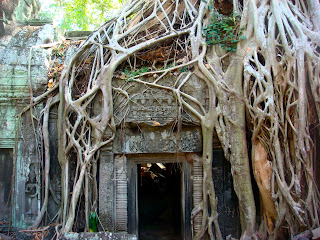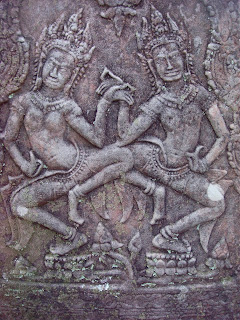This week I watched the 2003 PBS documentary The Flute Player (conveniently available on Hulu) in preparation for the "Season of Cambodia" arts festival. The Season of Cambodian arts festival is happening throughout April and May in New York with multiple exhibits and talks throughout the city. The film gave a good background on the arts in Cambodia, and notably how Pol Pot stifled arts and culture during the Khmer Rouge and through the Cambodian Civil War. The Khmer Rouge (and multiple other dictatorships) targeted artists because they employed great amounts of self-expression--directly against the Rouge's dogma. The Cambodian Master Performers Program (now called Cambodian Living Arts) is attempting to revive Khmer art and culture, namely music, and make Cambodia not "known for [the] killing fields or political conflicts" but rather "arts and culture" as an "international signature" (Arn Chorn-Pond in The Flute Player).
Arn Chorn-Pond is the son of an opera performer and opera house owner--and was nine years old when the Khmer Rouge took over. He was forced into a labor camp, but when the Khmer Rouge wanted to create a music group spreading their propaganda, he was able to play the flute and save himself. He still feels immense "survivor's guilt" and to mitigate this, he teaches Cambodian children music at a school in Lowell, Massachusetts as well as founded the Cambodian Master Performers Program.
In The Flute Player, he goes to Cambodia to find former artists that were suppressed by the Khmer Rouge, interviews them, and records their music. He does this with a total of five artists in the film: Kung Nai, Chek Mach, Yim Saing, Nong Chok, and Youn Mek. He meets with Kung Nai (below), known as the "Cambodian Ray Charles" for his blues style music and the fact that he is blind. He plays the chapei dong veng, or a guitar-like instrument. During the Khmer Rouge, Nai was forced to sing about the landowning class and capitalist exploitation, and although he did not agree with this, it kept him from being killed like so many other artists. After the Khmer Rouge, he continued singing non-controversial songs for fear that they would reemerge from the forests, where many of the former soldiers and commanders lived after Vietnamese liberation in 1979. Today, he sings in Cambodia and around the world.
Chorn-Pond also interviews Chek Mach, a famous opera singer in Cambodia before the Khmer Rouge. She claims that during the Khmer Rouge she would lay low in the rice fields with a basket on top of her head and walk from village to village singing. The people would give her food for her voice, ranging from bananas to MSG, she said (I like to believe this but am honestly skeptical). Most heart-wrenching was when Chorn-Pond reunitied with his flute teacher, Youn Mek, that he met in 1977 and taught him for the remainder of the Khmer Rouge. Mek thanks Chorn-Pond for sharing his food and keeping him alive (Chorn-Pond said that, along with not having to work in the rice fields, the Khmer Rouge gave him more food than the other children). The interviews combined with the music and Chorn-Pond's honest and raw emotions about the genocide makes the film very touching.
Ultimately the film proves that it is important to see Cambodia outside of a corruption-ridden and post-genocide context. Although a vital part of Cambodian history and a socio-demographic indicator, the Khmer Rouge history does not need to wholly define Cambodia and its people. Instead, the art forms emerging from this time can showcase Cambodia's rich culture that begin to move past genocide. The arts give more creative expression to the Cambodian people allowing them to define their agency in a world that still views their country as a Shangri-la-turned-death-camp.
While Chorn-Pond focuses on more traditional music, next week I will looking Cambodia's burgeoning contemporary art scene, going to Sopheap Pich's "Cambodia Rattan" exhibit at the Metropolitan Museum of Art, as well as the "Bomb Ponds" exhibition at the Asia Society Museum (the latter if I have got the time!).
Works Cited:
The Flute Player. Glatzer, Jocelyn Dir. PBS, 2003. Film
Embedded video taken from http://www.youtube.com/watch?v=PukOTKXs3bQ.
 |
| Arn Chorn-Pond at a Thai refugee camp. |
In The Flute Player, he goes to Cambodia to find former artists that were suppressed by the Khmer Rouge, interviews them, and records their music. He does this with a total of five artists in the film: Kung Nai, Chek Mach, Yim Saing, Nong Chok, and Youn Mek. He meets with Kung Nai (below), known as the "Cambodian Ray Charles" for his blues style music and the fact that he is blind. He plays the chapei dong veng, or a guitar-like instrument. During the Khmer Rouge, Nai was forced to sing about the landowning class and capitalist exploitation, and although he did not agree with this, it kept him from being killed like so many other artists. After the Khmer Rouge, he continued singing non-controversial songs for fear that they would reemerge from the forests, where many of the former soldiers and commanders lived after Vietnamese liberation in 1979. Today, he sings in Cambodia and around the world.
Chorn-Pond also interviews Chek Mach, a famous opera singer in Cambodia before the Khmer Rouge. She claims that during the Khmer Rouge she would lay low in the rice fields with a basket on top of her head and walk from village to village singing. The people would give her food for her voice, ranging from bananas to MSG, she said (I like to believe this but am honestly skeptical). Most heart-wrenching was when Chorn-Pond reunitied with his flute teacher, Youn Mek, that he met in 1977 and taught him for the remainder of the Khmer Rouge. Mek thanks Chorn-Pond for sharing his food and keeping him alive (Chorn-Pond said that, along with not having to work in the rice fields, the Khmer Rouge gave him more food than the other children). The interviews combined with the music and Chorn-Pond's honest and raw emotions about the genocide makes the film very touching.
 |
| Chek Mach and Arn Chorn-Pond in 1999. |
While Chorn-Pond focuses on more traditional music, next week I will looking Cambodia's burgeoning contemporary art scene, going to Sopheap Pich's "Cambodia Rattan" exhibit at the Metropolitan Museum of Art, as well as the "Bomb Ponds" exhibition at the Asia Society Museum (the latter if I have got the time!).
Works Cited:
The Flute Player. Glatzer, Jocelyn Dir. PBS, 2003. Film
Embedded video taken from http://www.youtube.com/watch?v=PukOTKXs3bQ.










.jpeg)



